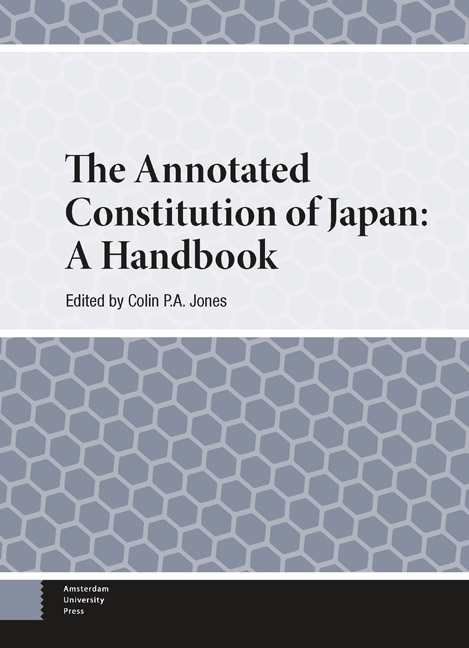Book contents
- Frontmatter
- Dedication
- Contents
- Contributors
- Preface
- Acknowledgements
- Introduction: Historical Overview
- The Preamble
- 1 Chapter I: The Emperor (Articles 1–8)
- 2 Chapter II: Renunciation of War (Article 9)
- 3 Chapter III: Rights and Duties of the People (Articles 10–40)
- 4 Chapter IV: The Diet (Articles 41–64)
- 5 Chapter V: The Cabinet (Articles 65–75)
- 6 Chapter VI: The Judiciary (Articles 76–82)
- 7 Chapter VII: Finance (Articles 83–91)
- 8 Chapter VIII: Local Self Government (Articles 92–95)
- 9 Chapter IX: Amendments (Article 96)
- 10 Chapter X: Supreme Law (Articles 97–99)
- 11 Chapter XI: Supplementary Provisions (Articles 100–103)
- Appendix 1 Constitution of the Empire of Japan (Japanese)
- Appendix 2 Constitution of the Empire of Japan (English translation)
- Appendix 3 The Potsdam Declaration
- Appendix 4 Instrument of Surrender
- Appendix 5 The “MacArthur Notes”
- Appendix 6 The GHQ Draft
- Appendix 7 The Constitution of Japan (Japanese)
- Appendix 8 The Treaty of San Francisco
- Bibliography
- Index
- Index of Articles of the Constitution of Japan
4 - Chapter IV: The Diet (Articles 41–64)
Published online by Cambridge University Press: 13 February 2024
- Frontmatter
- Dedication
- Contents
- Contributors
- Preface
- Acknowledgements
- Introduction: Historical Overview
- The Preamble
- 1 Chapter I: The Emperor (Articles 1–8)
- 2 Chapter II: Renunciation of War (Article 9)
- 3 Chapter III: Rights and Duties of the People (Articles 10–40)
- 4 Chapter IV: The Diet (Articles 41–64)
- 5 Chapter V: The Cabinet (Articles 65–75)
- 6 Chapter VI: The Judiciary (Articles 76–82)
- 7 Chapter VII: Finance (Articles 83–91)
- 8 Chapter VIII: Local Self Government (Articles 92–95)
- 9 Chapter IX: Amendments (Article 96)
- 10 Chapter X: Supreme Law (Articles 97–99)
- 11 Chapter XI: Supplementary Provisions (Articles 100–103)
- Appendix 1 Constitution of the Empire of Japan (Japanese)
- Appendix 2 Constitution of the Empire of Japan (English translation)
- Appendix 3 The Potsdam Declaration
- Appendix 4 Instrument of Surrender
- Appendix 5 The “MacArthur Notes”
- Appendix 6 The GHQ Draft
- Appendix 7 The Constitution of Japan (Japanese)
- Appendix 8 The Treaty of San Francisco
- Bibliography
- Index
- Index of Articles of the Constitution of Japan
Summary
Chapter IV of the constitution deals with the Diet, the legislature of Japan. Although the constitution establishes a three-way separation of powers, the Diet appears superior—the “highest organ of state power” and the “sole law-making organ of the State” (Article 41). This reflects the constitution's relocation of sovereignty to the Japanese people and their elected representatives. As will be seen in the following articles, the Diet performs several important functions in addition to legislation.
The Imperial Diet under the Meiji Constitution
“Deliberative assemblies shall be widely established and all matters decided by open discussion” was one of the mandates of the Meiji emperor in his Charter Oath of 1868. With the dissemination of knowledge of how western countries were governed, demands for a national, representative assembly became an important factor in post-Restoration politics. These were ultimately met with the promulgation of the Meiji Constitution, which established the Imperial Diet, the predecessor of the current Diet. There is limited continuity between the two Diets. The Imperial Diet had two houses: the elected House of Representatives (Shūgiin; the same name as under the current constitution) and the appointed House of Peers (Kizokuin). Under the Meiji Constitution the Imperial Diet performs certain functions of government in tandem with the ministers of state and the judicature, but without a well-developed separation of powers.
In contrast, the present Diet is different from the Imperial Diet in many ways, most of which can be explained by the status of the emperor. Under the Meiji Constitution, the emperor was the holder of absolute sovereign power (sōransha) (Article 4), and enacted laws “with the consent of “ the Imperial Diet (Article 5). Due to his status as sōransha, the emperor had a veto over bills that were passed by both chambers of the Imperial Diet, which could be exercised by the emperor not giving assent (saika) (Article 6). Furthermore, under the Meiji Constitution the emperor could rule by decree in certain circumstances without the support of the Imperial Diet (Articles 8 and 9). The emperor monopolized the power to command the army and navy without interference from the legislature (Articles 11 and 12), except through the budget process.
- Type
- Chapter
- Information
- The Annotated Constitution of JapanA Handbook, pp. 191 - 228Publisher: Amsterdam University PressPrint publication year: 2023

